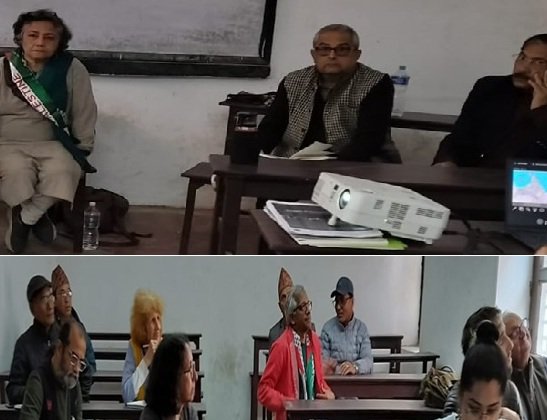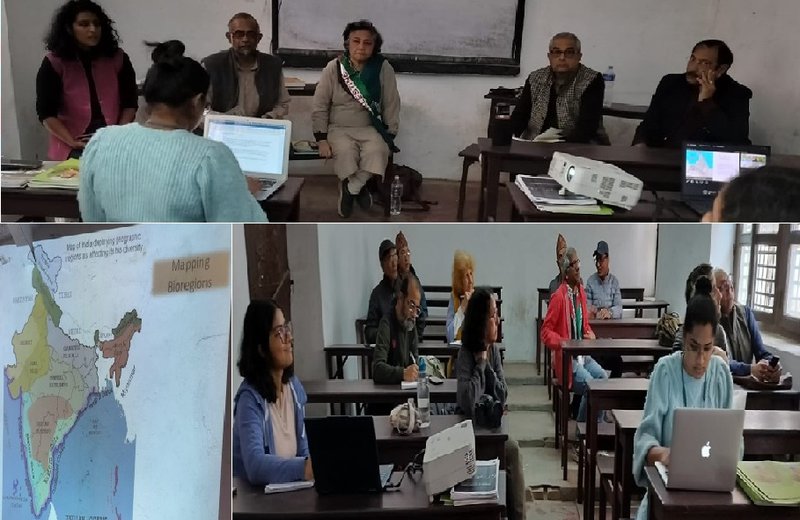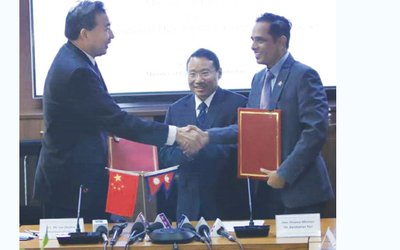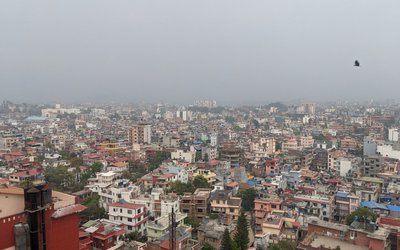
World Social Forum (WSF) 2024 just concluded its five-day event in Kathmandu on 19th February. With over 50 thousand participants from 1400 organizations of 98 countries, it might have set a record as one of the largest international gathering in Nepal. Maybe also a record of sorts: unlike other international events, it saw barely any coverage in Kathmandu’s mainstream Sahuji media, leaving many unaware that something as big as this was even going on! Held not in five-star hotels as is often the case with international gatherings, but at the open-air Bhrikuti exhibition grounds under makeshift tents and adjacent classrooms of Law and Ratna Rajya college classrooms, a casual passerby could have mistakenly thought it was just another crowded mela or bazaar. “Simple living and high thinking” remains the driving ethos behind what this gathering of social and environmental activists ismainly about.
WSF started as an antidote to the World Economic Forum (WEF, the “Davos gang”!) where the world’s billionaires and multinationals meet annually at a Swiss ski resort to discuss how to make the world more comfortable for trade and business. Realizing that, in their pursuit of profit WEF were making short shrift of social and environmental justice, Latin Americans began the process of dialogue among activists to counter neoliberalism’s unbridled pursuit of profit with an alternative of action for compassion and equity. After the first WSF meeting in Porte Allegre in 2001, the forum has expanding into other centers in the Global South, the last and 16th having just been held in Kathmandu.
Given its sheer diversity in both issues and activists from around the world – the first day for instance saw over 120 parallel sessions! – it is nothing short of a miracle that groups with common activism interests did manage to agree and bring out resolutions and program for further action. The Resolution brought out by river activists for example – including the well-known Narmada Bachao Andolan, Kosi Victims Society, Ganga Mukti Andolan and others – resolves inter alia to work towards an alternative radical agenda:
- educating ourselves on our riverine histories, contemporary challenges and threats through a multi-disciplinary lens, putting the most marginalized riparian communities and their knowledge at the center of shared river dialogues
- resisting the commodification, appropriation, exploitation and pollution of our rivers that threaten rivers and riverine values
- rejecting reductionist engineering-based water knowledge and climate solution to advocate for community-centered water and river governance based on holistic approaches of climate justice
These are not understandings and actions that will go unchallenged by the powers-that-be who benefit from the status quo and everything that activists are opposed to. And this has been recognized by WSF participants. The 2007 event in Kenya was criticized for the unhealthy role of “exclusive rights” enjoyed by sponsoring international business groups to the exclusion of local businesses; and the 2009 event in a city in the Brazilian rainforest was criticized for being NGO-dominated that marginalized popular movements. Indeed, many international conferences on water or climate have been hijacked by sponsoring business interests who have also had an unhealthy, insidious influence on the agenda and the final resolutions. The most blatant was the latest COP28: although carbon trading has been scandal-plagued, it failed to agree on integrity rules for market players!
The current post-Covid, post-Ukraine/Gaza unfolding world disorder is exposing the post-World War-2 Bretton Woods arrangement that essentially promoted neo-colonialism in the guise of development. And this was most insidious with the rise of NGOs from the 1980s and the push for Structural Adjustment Loans and the marginalization of the State by the global financial institutions: while economic development was to be done by the deified Market, social issues were to be managed by tame NGOs (mercifully under this rubric some local issues-based activist NGOs have also emerged and survived). With this stroke of strategic planning, Bretton Woodsters were able to marginalize genuine, volunteerism-based traditional civic voices.

In Nepal, the mushrooming of NGOs since the 1990s (in reality, government-, donor-, business-, and political party-based GoNGOs, DoNGOs, BoNGOs and PoNGOs) have completely undercut the traditional guthis. It is they that have kept alive much of the arts, culture and religious artifacts of the country over the last centuries. Thankfully, despite lack of government support – indeed in the case of the “guthi land nationalization act” scandal a few years back that was thankfully torpedoed by their street-level activism – they continue to survive and did indeed provide much of the voluntary relief services during the 2015 earthquake.
It was impossible to attend but a fraction of the events; but the general mood amidst the wide diversity of social and environmental causes roiling the participants was one of solidarity for social justice and expanding their network of support among those of good will. I had the good fortune to participate in the discussions on Bioregionalism organized by Kalpavriksh, INTACH, Woven Design Collaborative and Nepal Water Conservation Foundation folks, a session that was indicative of the concerns, commitment and intellectual depth participants came with.
Boundaries, be they political or administrative, have been the hallmarks of nation-states and the bane of the natural environment as well as communities living next to ordivided by such boundaries. It has been said that the main task of nation-states is “bordering, ordering and othering”. It is in this process of “ordering” by governments that the “othering”occurs leaving communities marginalized and vulnerable, as well as environment such as rivers, forests and wildlife desecrated. In much of South Asia, it was the British Raj and its colonial enterprise that drew the political and administrative boundaries to suit their resource extractive needs. That process ignored the traditional understandings of those living there of their physical, ecological and cultural space and the generations of relations they built around them.
The Westphalian nation-state model, born out of the European experience but alien to the rest of the world’s historical experience, imposed an unnatural homogeneity on this rich civilizational and ecological tapestry, and sought to merge multiple identities that people in this part of the world naturally enjoyed into one monochrome. The political project ended up trying to create one language, religion, dress, even national bird and food to enhance its “ordering” power. In this effort, it found a willing partner in the market whose push for efficiency to enhance its profit resulted, to borrow the words of Karl Polanyi, in feeding citizens with rich socio-cultural identities into a “satanic mill” to produce alienated and individualized labour with “only their hands to sell” as Marx would have described it.
Thus, was born the current dominant public-private partnership (PPP, instead of PPCP or public-private-civic partnership) where much of the public needs were made subservient to powerful private interests.Bioregionalism – and indeed much of other WSF concerns – is an effort to push back against this rapacity and resulting alienation, to regain meaningful lives, livelihoods as well as environmental health for the majority 99% currently getting increasingly poor and marginalized. It means regaining social and environmental well-being by redrawing the boundaries of governance, especially at the lowest village and township levels, by advocating stewardship on behalf of this and future generations instead of ownership today by the powerful.
In Nepal, a bioregional advocacy would have certain natural advantages: with some 124 ethnic groups and 103 languages, with a geography that goes from tropical 60m above sea level to arctic 8848m thus containing almost all the climatic zones of the world in a 150 to 200 km range, diversity is Nepal’s hallmark. Not having been under direct colonial rule (but still influenced by it), many traditional natural resource management institutions are still alive and intact. That is what made initiatives like community forestry, irrigation, and later community electricity possible here and not in India down south. Promoting less water consuming and more healthy dryland crops such as millet and barley has been made easier by a highly developed tourism industry that is currently promoting ethnic restaurants that serve food ecologically relevant to such ethnic groups.
But there are major challenges. Hydroelectricity-powered ropeways (a climate- and mountain-friendly technology which made its advent in Nepal a century ago and is 3 times cheaper, 8 times faster to build and consume only half the energy in megajoules to transport goods compared to equivalent diesel-consuming hill roads) still find no policy support. Bretton Woods and globalization-imposed trade liberalization means locally grown, low carbon footprint food items are being displaced by those coming from far abroad even as they burn cost-externalized-to the environment fossil fuel. None of that is sustainable, even without the uncertainties of climate change and a collapsing old global order.
This is where bioregionalism offers conceptual and practical avenues to develop an alternative world where much of today’s mal-development can be corrected and avoided. Indeed, to borrow from Marx, one might say: “Bioregions of the world, Unite! You have nothing to lose but the mal-developments visited upon you!”

Dipak Gyawali
Gyawali is Pragya (Academician) of the Nepal Academy of Science and Technology (NAST) and former minister of water resources.
- Maldevelopment And Technology: Ethos Harbingering Coming Apocalypse
- Apr 03, 2024
- Remembering An Inspiring Karma Yogi
- Jan 09, 2024
- New World Disorder And The Case For Ideology
- Dec 13, 2023
- Loktantra’s Moral Turpitude
- Nov 06, 2023
- Will Nepal Leapfrog In Its Mobility?
- Sep 20, 2023















